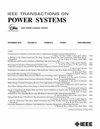MV-LV Rule-Based Control of EV Charging Using Limited Network and Monitoring Data
IF 7.2
1区 工程技术
Q1 ENGINEERING, ELECTRICAL & ELECTRONIC
引用次数: 0
Abstract
The widespread adoption of electric vehicles (EVs) will increase the peak demand of existing medium voltage (MV) and low voltage (LV) distribution networks, affecting assets and customer voltages. An alternative to costly reinforcements is the adequate real-time control of EV charging. However, most studies that investigate such control often require detailed electrical network models and real-time smart meter data. While distribution companies have MV network models, LV ones are rare. And despite the rising adoption of smart meters, their real-time usage is uncommon. This paper proposes a hierarchical rule-based control of EV charging in unbalanced, large-scale MV-LV networks. Only using asset associations and limited monitoring (from transformers and charging points), it calculates adequate EV charging setpoints across the MV-LV networks, successfully managing high EV penetrations in large areas. Its effectiveness is compared to a linearized AC Optimal Power Flow (OPF)-based approach using a real Australian MV-LV network with 3,300+ residential customers, considering high EV and photovoltaic (PV) penetrations. Results demonstrate that the proposed approach can mitigate voltage and thermal issues as effectively as the benchmark OPF-based approach, and with limited impacts on EV charging delays. It provides a practical, implementable solution for distribution companies to control EVs in large-scale networks.基于有限网络和监测数据的MV-LV规则电动汽车充电控制
电动汽车的广泛采用将增加现有中压(MV)和低压(LV)配电网的峰值需求,影响资产和客户电压。一种替代昂贵的强化措施是对电动汽车充电进行充分的实时控制。然而,大多数调查这种控制的研究通常需要详细的电网模型和实时智能电表数据。虽然分销公司有中档网络模式,但低压网络却很少。尽管越来越多的人采用智能电表,但它们的实时使用并不常见。提出了一种基于分层规则的不平衡大型MV-LV网络电动汽车充电控制方法。仅使用资产关联和有限的监控(来自变压器和充电点),它就可以在MV-LV网络中计算出足够的电动汽车充电设定值,成功地管理了大范围内的高电动汽车渗透率。将其有效性与基于线性化交流最优潮流(OPF)的方法进行了比较,该方法使用了一个真实的澳大利亚MV-LV网络,拥有3300多个住宅客户,考虑到高EV和光伏(PV)渗透率。结果表明,该方法可以像基准的基于opf的方法一样有效地缓解电压和热问题,并且对电动汽车充电延迟的影响有限。它为配电公司在大规模电网中控制电动汽车提供了一种切实可行的解决方案。
本文章由计算机程序翻译,如有差异,请以英文原文为准。
求助全文
约1分钟内获得全文
求助全文
来源期刊

IEEE Transactions on Power Systems
工程技术-工程:电子与电气
CiteScore
15.80
自引率
7.60%
发文量
696
审稿时长
3 months
期刊介绍:
The scope of IEEE Transactions on Power Systems covers the education, analysis, operation, planning, and economics of electric generation, transmission, and distribution systems for general industrial, commercial, public, and domestic consumption, including the interaction with multi-energy carriers. The focus of this transactions is the power system from a systems viewpoint instead of components of the system. It has five (5) key areas within its scope with several technical topics within each area. These areas are: (1) Power Engineering Education, (2) Power System Analysis, Computing, and Economics, (3) Power System Dynamic Performance, (4) Power System Operations, and (5) Power System Planning and Implementation.
 求助内容:
求助内容: 应助结果提醒方式:
应助结果提醒方式:


